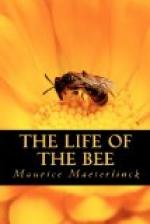Then came Reaumur, who, pursuing similar methods, made a vast number of curious experiments and researches in his gardens at Charenton, and devoted to the bees an entire volume of his “Notes to Serve for a History of Insects.” One may read it with profit to-day, and without fatigue. It is clear, direct, and sincere, and possessed of a certain hard, arid charm of its own. He sought especially the destruction of ancient errors; he himself was responsible for several new ones; he partially understood the formation of swarms and the political establishment of queens; in a word, he discovered many difficult truths, and paved the way for the discovery of more. He fully appreciated the marvellous architecture of the hive; and what he said on the subject has never been better said. It is to him, too, that we owe the idea of the glass hives, which, having since been perfected, enable us to follow the entire private life of these fierce insects, whose work, begun in the dazzling sunshine, receives its crown in the darkness. To be comprehensive, one should mention also the somewhat subsequent works and investigations of Charles Bonnet and Schirach (who solved the enigma of the royal egg); but I will keep to the broad lines, and pass at once to Francois Huber, the master and classic of contemporary apiarian science.
Huber was born in Geneva in 1750, and fell blind in his earliest youth. The experiments of Reaumur interested him; he sought to verify them, and soon becoming passionately absorbed in these researches, eventually, with the assistance of an intelligent and faithful servant, Francois Burnens, devoted his entire life to the study of the bee. In the annals of human suffering and human triumph there is nothing more touching, no lesson more admirable, than the story of this patient collaboration, wherein the one who saw only with immaterial light guided with his spirit the eyes and hands of the other who had the real earthly vision; where he who, as we are assured, had never with his own eyes beheld a comb of honey, was yet able, notwithstanding the veil on his dead eyes that rendered double the veil in which nature enwraps all things, to penetrate the profound secrets of the genius that had made this invisible comb; as though to teach us that no condition in life can warrant our abandoning our desire and search for the truth. I will not enumerate all that apiarian science owes to Huber; to state what it does not owe were the briefer task. His “New Observations on Bees,” of which the first volume was written in 1789, in




